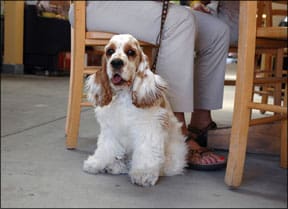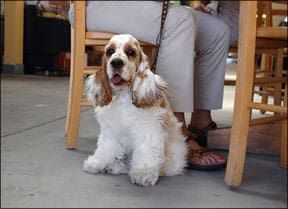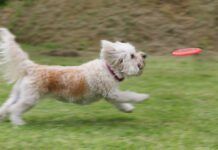Most dog owners are pleased when their dogs are calm – even the owners of high-energy competition and working dogs, when those dogs are “off-duty.” Some owners may go to great – sometimes misguided – lengths to achieve the coveted calm condition. Humans who understand the appropriate way to help a dog learn to be calm can make the difference between the canine companion who finds a lifelong loving home, and the one who ends up – sometimes several times in his life – gazing sadly out from the chain-link kennels of an animal shelter.
Calm is a highly valued, hard-won, and sometimes transitory state in our own household. With four dogs in the Miller pack, two of them proud representatives of the herding group, calm is something we have to work at. We use the time-honored recipe of exercise, management, and training (and of course, lots of love) to help our canine family members be a peaceable pack.

288
The “Uncommonly Calm” (UC) Program
You can turn your Bouncing Betty into a Sedate Sally by following a simple program that helps her get rid of excess energy, prevents her from being rewarded for out-of-control behavior, and consistently rewards her for being calm.
Exercise: The first element in your UC program is to provide your dog with lots of exercise. Wise dog trainers and owners know that a tired dog is a well-behaved dog. Often when your dog is at her worst, she is simply brimming with energy bursting to find an escape. Tug-o-war on your pants leg, donuts around the dining room table, and record high-jumps over the back of the sofa are just some of her outlets for that pent-up energy.
Mental and physical activities are both vitally important parts of a canine exercise program. For the physical side, schedule at least three tongue-dragging sessions of chase-the-ball per day. Climb to the top of a hill or carpeted staircase (perhaps not for long-backed dogs) and throw the ball down so she has to keep climbing back up to return it to you. Set up an obstacle course with lots of things to climb and jump over. Be careful not to send her into heatstroke, but definitely play until she’s pooped. Keep your exercise program breed-appropriate – an athletic Border Collie will need lots more physical challenges than an English Bulldog.
Don’t think that a walk around the block will do it. A walk on leash, even a long walk, is nothing but an exercise hors d’oeurve for a young dog. You’re tired when you get home from the walk, but your dog is just getting warmed up! If no one in the family has time to give your dog adequate exercise, arrange for a pet sitter to come by a couple of times a day and wear her out, or take her to doggie daycare as often as possible. Eight hours of romping with other dogs is guaranteed to take the wind out of her sails! (See “All in a Day’s Care,” Whole Dog Journal April 2001.)
Caution: Check with your veterinarian prior to starting your dog on a vigorous exercise program. Just as with humans, too much exercise too suddenly can damage canine joints and muscles. Out-of-shape and overweight dogs especially will need to ease into a physical exercise program.
Mental exercise is an often-overlooked but valuable tool in your UC arsenal. Mind games can be every bit as tiring for your dog as running games, and are a good choice in conjunction with physical exercise during inclement weather, and/or as an alternative for dogs with physical limitations. Interactive toys, shaping games, and clicker training are all good mind candy for your overactive canine pal. (See “Mind Games,” October 2004.)
Manage: The second piece of a successful UC program is management. In addition to regular exercise, you can make other changes in your dog’s routine to manage inappropriate behavior.
If your high-energy dog grabs forbidden objects and races around the house, it’s probably because she’s learned that this triggers a wonderful game of “chase the dog!” This is very fun and rewarding for her – and behaviors that are rewarded increase. The management answer is to keep forbidden objects out of her reach, and avoid falling into her trap of chasing when she grabs something. Instead, walk to your cupboard, take out a tasty treat, and offer to trade for the object. Then put it out of her reach. (For much more on managing your dog’s behavior, see “Upper Level Management,” August 2001.)
Another piece of the management puzzle is physically controlling your dog’s behavior through the judicious use of leashes, pens, crates, and tethers. (See “Tethered to Success,” April 2001, and “Crate Training Made Easy,” August 2000.)
Training: The final important element of your UC program is training. The more training you do with your dog the easier it is to communicate with her. The better she understands your communications, the easier it is for her to follow your instructions and comply with your requests.
Click for calm
Whether you have a baby dog with normal puppy energy, an obstreperous teenager, or an adult dog who has good manners lessons to catch up on, clicker training can be a magically effective and gentle way to convince a dog to calm down. No yelling, no physical punishment; just clicks and treats for any pause in the action.
The biggest challenge with a high energy dog is that the instant you try to praise or reward, she’s bouncing off the walls again. Timing and consistency are key to successful training. If a reward is given more than a second or two beyond the desired behavior, the dog has lost the connection, and believes she’s being rewarded for whatever she’s doing now.
It’s nearly impossible to have good timing if it requires delivering the treat to the excitable dog while she’s momentarily calm. By the time you get the treat to her mouth she’s once again doing her Bouncing Betty act. She may well perceive the treat as a reward for her jumping jacks rather than for the sought-after calmness that occurred briefly, several seconds ago.
However, once a dog has learned the connection between the “click” and a pending reward, your timing can be impeccable: an instant of calm elicits a “click” – the treat can arrive several seconds later. An added advantage of the clicker is that most dogs, when they hear the click, pause in anticipation of the coming morsel, drawing out the brief period of relatively calm behavior even longer.
At the same time you’re laying a foundation of exercise and management, you can begin an effective clicker-training program. Don’t procrastinate – you can accomplish this on the first day of your UC program.
Start by “charging the clicker” – officially known in behavior circles as “conditioning the reward marker.” Begin by clicking the clicker in your pocket, to avoid startling your dog with the sharp sound. Click the clicker, feed your dog a treat. Click and treat. Click and treat. As she begins to associate the sound with the treat, bring the clicker out of your pocket and click it in a more natural position at your side or your waist.
Your dog doesn’t have to do anything special to get the click and treat, as long as she isn’t doing something unacceptable, like jumping on you or chewing the corner of the coffee table. If necessary, use a leash or tether to keep her out of trouble while you click and treat. Most dogs realize within a half-dozen repetitions that the click means a treat is coming. When your dog’s ears perk and her eyes brighten at the sound of the click, you know she’s getting it. Now you can use your charged clicker for training.
The goal of clicker training is to get your dog to understand that she can make the click happen by offering certain behaviors – in this case, calm. At first, you can’t wait for long, leisurely stretches of calm behavior to click; you won’t get them! You might begin by giving your dog a click and treat just because all four feet are on the floor at the same instant. Be quick! You want her to understand that the behavior she was rewarded for was pausing with all four feet on the floor, so your timing needs to be sharp; the click needs to happen the instant all four feet are down. If you click late, you may be reinforcing her bouncing around – the exact opposite of what you want!
If your timing is good and you catch her with four-on-the-floor several times in a row you’ll see her start to stand still deliberately, in order to make the clicker go off. Light bulb moment! A door has opened in her brain, and you can now see her thinking. This, to me, is one of the most exciting moments in dog training – when the dog realizes that she can control the clicker. A whole new world of communication has just opened to her. You now have a very powerful tool in your little plastic clicker box. You can use it to reinforce any behavior you want, any time it happens, and your dog will quickly start repeating that behavior for you.
Okay, back to calm. How does “pausing briefly on all four feet” translate into a calm dog? Very gradually. You are going to “shape” the pause into longer and longer periods of stillness, by extending the time, in milliseconds at first, that you wait as she is standing still before you click and treat. If you err and she starts to jump around again, just wait. Eventually, there will be another pause that you can click, and then start the shaping again.
As she gets better at being calm for longer and longer periods, be sure to reinforce randomly – sometimes for shorter pauses, sometimes longer. If you just keep making it harder and harder – longer and longer – she may get frustrated and quit playing the game.
Each training session should be relatively short, to avoid frustration for both of you, but you can do several in a day. You’ll have the most success, at least at first, if you practice clicking calm right after one of her exercise sessions when she’s tired anyway. As she gets the idea that “calm” is a very rewardable behavior, it will work even when she has more energy.
When your dog is holding still for several seconds at a time, add the verbal cue of your choice – something like “Easy!”, that you will be able to use (eventually) to cue her into calmness. Over time, you’ll be able to phase out the click and treat for calm behavior and use other rewards such as calm praise, a gentle massage, or an invitation to lie quietly next to you on the sofa.
Go to your place
You can use your management tether and your clicker to teach your dog a very useful calming exercise, called “go to your place.” Fix up her tether station so it’s very comfortable, with a soft bed, really good chew toys, and unspillable water. Toss a treat onto the bed and say “go to your place.”
When she gets there and is about to snatch up the treat, click your clicker. Repeat several times, clicking and treating each time, until she goes to her spot easily. Then attach the tether to her collar. Sit in a chair nearby but out of her reach, and read a book.
If she fusses, ignore her. When she’s quiet, click, and toss her a treat. This is “positive reinforcement” – her good behavior makes something good happen – she gets a click and treat. Occasionally when she’s being calm, get up, go over to her bed and quietly pet and praise her. This is also positive reinforcement. If she starts to get excited when you’re with her, go back to your chair and sit down again. This is “negative punishment” – her inappropriate behavior makes something good go away – you leave. Negative punishment is considered effective and humane by most positive trainers.
When she’s calm on her tether for long stretches – up to 5 or 10 minutes with occasional treats and visits – you can remove the tether and continue to reward her for lying calmly on her bed. If she revs up again, re-tether her and practice more calm. You’ll also want to practice this when you have visitors. First, give your dog an extra tiring play-session before your guests arrive so she can be on her best behavior. Have her on her bed, tethered if necessary, and wait until she’s calm to allow guests to greet her. When she’s relaxed, untether her so she can mingle with the visitors politely. If she gets carried away, she can do another session on her tether.
Self control
Dogs who have a great deal of trouble with the concept of calm are often dogs who have difficulty with impulse control. The “wait” exercise can be a very useful part of your UC program, especially for dogs who are short on impulse control. I teach the wait behavior using my dogs’ food bowls, and at doorways. Since they get two meals a day and I let them in and out several times in any given 24-hour period, we have countless built-in opportunities to practice this important self-control skill. Once they learn it, the self-control “wait” easily generalizes to other situations.
Here’s how I teach them:
Wait for food: With your dog sitting at your side, tell her to “wait.” Hold the food bowl (with food it in, topped with tasty treats) at your chest, then move it toward the floor 4 to 6 inches. If your dog stays sitting, click and feed her a treat from the bowl. If your dog gets up, say “Oops!” and ask her to sit again. If she remains sitting, lower the bowl 4 to 6 inches again, click and treat. Repeat this step several times until she consistently remains sitting as you lower the bowl.
Gradually move the bowl closer to the floor with succeeding repetitions until you can place it on the floor without your dog trying to get up or eat it. Finally, place the bowl on the floor and tell her to eat. After she’s had a few bites, lift the bowl up and try again, lowering the bowl a little farther this time. Repeat these steps until you can place the bowl on the floor and she doesn’t move until you tell her she can.
Any time your dog starts to get up as you move the bowl toward the floor, use the “oops” no-reward marker to let her know getting up makes the good stuff go away, and raise the bowl out of her reach. Have her sit and try again. If she gets up several times in a row, you are asking for too much too soon; move the bowl in smaller increments.
Caution: If your dog guards valuable resources such as her food bowl, consult with a qualified positive behavior professional before trying this exercise. Wait at the door: With your dog sitting at your side, tell her to “wait.” Reach for the doorknob. If she doesn’t move, click and treat. Repeat this step several times. Then jiggle the door knob. Click and reward her for not moving. Repeat this step several times. Slowly open the door a crack. Again, click and treat if she doesn’t move, and repeat. Gradually open the door farther, an inch or two at a time. Do several repetitions at each step, with clicks and treats each time.
Eventually you’ll be able to walk all the way through the door, stop, and face your dog, without having her move. Wait a few seconds, click, then return and give her a tasty treat. Of course, sometimes you’ll actually give her the okay to go out the door ¨C she has to go out sometime!
If you have multiple dogs, teach them each to wait at the door, and then you can really have fun! Using a little body-blocking as necessary – stepping in front of the dog(s) you’re not releasing – invite them out the door one at a time by name. This is very useful for those times when you really do only want one or two – not all – your dogs to go with you to the outside world.
UC in the Miller household
As I write this, our dogs are, indeed, calm. Lucy, a high-energy Cardigan Corgi (who has difficulty with impulse control), is in the living room watching a football game on the recliner with my husband Paul. Missy, an older but still active Australian Shepherd, is snoozing in her crate in the living room, while Dubhy the Scottie is sound asleep on the other recliner. Bonnie, a young Corgi/Scottie mix, is curled up in her crate under the table in my office. There’s no movement from any of them.
This doesn’t happen by accident. Most mornings we’re up and out to the barn to feed horses by 5:30 am, dogs at our heels. Their first hour of the day is spent chasing dog toys (and each other) up and down the barn aisle, playing “king of the hay bales,” scavenging for dropped bits of grain, and pretending to herd horses as we lead them out to their pastures. This uses up enough energy that the pack can spend a quiet morning in the house with me while I’m on the computer.
Later on, weather permitting, we share lunch in the backyard. Lucy retrieves toys that I toss for her while I eat, and Bonnie retrieves Lucy. Missy and Dubhy, older and less energetic, watch calmly.
There are a variety of other activities we might incorporate into our day, including training sessions, and games with interactive toys. Lucy is especially taken with the new generation of puzzle toys, such as ZooActive’s Dog Tornado. [Editor’s note: Pat will be reviewing the entire line of ZooActive’s interactive puzzles for dogs, from Pawlickers.com, in an upcoming issue.]
Sometimes one or more of the dogs is called into service as a neutral dog for a dog-reactive private client, or a canine play-partner for a soft or undersocialized dog who doesn’t engage well with others during group class playtime. On a really good day we set aside time for a dog-pack hike around our 80-acre farm. This is, without a doubt, the Miller dogs’ favorite activity. And, of course, we always practice wait for food bowls and at doors.
None of this wears them out completely. The instant I roll my chair away from my desk, three sets of girlie dog-paws leap into action and three pairs of canine eyes light up at the prospect of the next activity. (Dubhy, the true sloth of the group, conserves energy, happy to lie in his crate until he’s convinced there’s something exciting in the offing – for sure.) What the Miller UC program does do is give our dogs enough exercise, management, training – and love – to allow them to be relaxed and calm when I need them to be.
Pat Miller, CPDT, is Whole Dog Journal’s Training Editor. Miller lives in Hagerstown, Maryland, site of her Peaceable Paws training center. Pat is also author of The Power of Positive Dog Training; Positive Perspectives: Love Your Dog, Train Your Dog; and Positive Perspectives II: Know Your Dog, Train Your Dog. See “Resources,” page 24.






